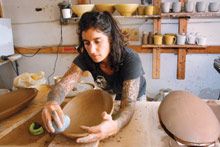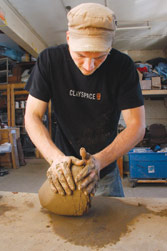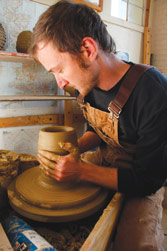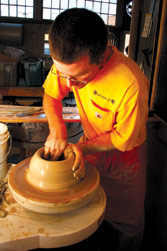In relationships, close quarters can build strong bonds or fierce resentments. Think of spouses co-owning a business or siblings sharing a bedroom. At the Clayspace Co-op, a working ceramics studio in Asheville’s River Arts District, the six members manage to cohabitate with relative ease.

“The internal competition is a great thing. Success breeds success,” notes Kyle Carpenter (whose recent work, exhibited at American Folk Art & Framing and Asheville Area Arts Council, depicts hauntingly gorgeous birds against earthy, salt-fired stoneware). Carpenter has been with the collective for more than a year now.
Clayspace co-founder Josh Copus expands on the idea of success. “This summer has been incredible,” he enthuses. “It’s been building for a while, but the amount of work we’ve sold out of the studio is phenomenal. It’s a big change from the early days when there were still prostitutes and drug addicts wandering around. Now there’s a steady stream of tourists.”
The 1,200-square-foot studio boasts a sun-dappled gallery space in its backroom; ironically (or perhaps fittingly), that gallery area was the start of the co-op in 2003, when Copus and fellow potters Matt Jacobs and Sean Fairbridge sublet the room from a woodworker. Much has changed in the five years since: Fairbridge now lives in New Mexico, while Copus and Jacobs—UNCA students at Clayspace’s onset—have graduated and launched viable careers. And the River Arts District has evolved from a collection of off-the-beaten-path artists’ studios to a known arts destination complete with renovations and rising rents.

At Clayspace, members do everything from digging their own clay and firing their own kiln to marketing their wares. (Really, they do everything clay-related short of bunking in the studio—and more than one of the potters has done that in the past). Yet members say they don’t feel threatened by the changes afoot. “Our philosophy is we can grow with it,” says Copus. “Instead of being priced out and pushed out, we can grow with it.”
Ahead of the class
Clayspace—and the reputations of its artists—carries weight these days. Consider:
• Copus, Jacobs and Eric Knoche are currently showing their work at the juried, invitation-only exhibit Fire and Light in Flat Rock;
• Carpenter’s work appears this month in an invitational exhibit in Santa Barbara, Calif.;
• Heather Tinnaro will be teaching a teapot class at Asheville’s Odyssey Center for Ceramic Arts this winter;
• Melissa Weiss crafted the mugs for the Chocolate Lounge, dishes for Cucina 24 and vases for the restaurant Table (all in Asheville);
• Knoche, who was recently accepted into the Southern Highland Craft Guild, is spending four months studying in Japan under the tutelage of national treasure Isezaki Jun.

But the co-op’s beginnings were humble enough. The rented corner of the woodworking shop wasn’t intended as a business upstart, but an escape from the structures of university life.
“The studios at UNCA were small and they closed at midnight,” Copus recalls.
Jacobs adds, “We wanted to stay up late and make big pots. Being that we had thrown pots already, we ran out of space quicker than other students.”
Their maverick inclinations met with initial disapproval from classmates and professors. “It’s like we were in the ‘bad club,’” Jacobs says with a laugh. “But we were still using [UNCA’s] facilities and their clay. By the end of our senior year, teachers were coming here to do critiques. They came our way an inch if not a mile.”
The end result was that Clayspace provided not just extra space for the ceramists, but also a smooth transition from school to the professional world.

“We were used to talking to people off the street and having strangers look at our work,” Jacobs points out. To complement the working-studio atmosphere, Copus used funds from a $15,000 Windgate Fellowship he won in 2006 to purchase land in Madison County where he built the Community Temple, a 27-foot-long kiln. (The Windgate Fellowship is a program spearheaded by the Hendersonville-based Center for Craft, Creativity and Design, in which universities across the country are invited to nominate student artists for the panel-juried awards.)
“It’s all a tool because coming out of school, when all that [support] evaporates, a kiln is what you need,” Copus explains. “My idea with the kiln was it could be that tool for me and for everyone here.”
All kilns have names, he reveals. “Community Temple” came from an installation project of Copus’ called “Building Community” in which bricks were labeled either “individual” or “community.” (One of the “community” bricks inspired the Wedge Brewery’s Community Porter.) “I’m interested in creating something bigger than myself,” the potter muses. “That’s what this space is about.”
As for the “Temple” reference, Copus says, “I live and breathe pottery. Clay, the community, it’s my spiritual outlet.”
The clay is hand-dug, the kiln hand-built
Copus not only lives and breathes pottery, but also digs his own clay. Experimentation with the wild, raw material, found in a tobacco farmer’s field in Leicester, was what earned Copus the Windgate Fellowship. The potter harvested about 184 tons (that’s about a 40-year supply for the co-op) of clay with a backhoe and dump truck, rendering his pots local in the truest sense of the world. But that clay is not only a conceptual part of Clayspace’s output: It puts a very distinct stamp on the pots.
The Leicester clay contains a high iron content, so when fired without glaze, it takes on a rusty metal look. Copus, Jacobs and Knoche all demonstrate in their work the roughcast nature of the wild product, which adds to both the organic feel of their work and the palpably masculine character. (Wild clay, its natural makeup still intact, is far less predictable than commercial clays, which are a blend of raw clay and other elements that make it easier to use.)

“Rugged, brawny,” is how Carpenter describes these pots. Many are oversized. They’re gracefully rendered, yet muscular and assured, bold in texture and shape, earth-toned and elegantly simple. “There’s a little bit of crudeness that comes from the firing, but not in a bad way,” Carpenter adds. Indeed, these are vessels unabashed by their terrestrial origins.
There is something refreshingly virile about the earthenware coming out of Clayspace. Perhaps it’s the sheer size of the pots. Carpenter admits to being asked once if he threw big pots because his studio mates were throwing big pots. He quips, “Maybe I am keeping up with the Joneses a little bit.” And Jacobs notes, “The reality of the market is that there are people buying big homes and they need big art to fill them.”

But bigger isn’t always better: Equally represented are the collections of female members Melissa Weiss and Tinnaro. That’s right, Clayspace isn’t a boys’ club.
“One reason I [brought] Melissa in was to bring balance,” Copus explains. “It’s something I think is important. We all bring an energy to the space. There’s a power in numbers.”
Perhaps it’s the Renaissance-style versatility of the co-op members. After all, they built their studio and the business from the ground up—from scraps and castoffs. Their clay is hand-dug, their kiln hand-built with bricks torn up and discarded from an old street. Their pots are fired with wood gathered at the side of the road.
“It’s a cool way to build something, in small steps within your means,” Copus offers. “Pottery has an especially strong history with that mentality. People are always making their own tools.”
Meet your maker
The potters at Clayspace are not only dedicated to their handiwork, but to passing the handmade aesthetic on to customers.
“It’s Christmas and people buy stuff because they think they have to, but even so, it’s more meaningful to have stuff that’s one-of-a-kind,” suggests Weiss.
Carpenter adds, “In a mass-produced world, it’s important to have handmade objects around you. All these mugs have stories.”
Copus, who is rarely without his handmade travel mug (the way most of us have a plastic coffee cup in tow) says, “It used to be that all this [ceramic] stuff was necessary. Pots were the way.”
Indeed, settlers to this area depended on clay jugs for vinegar, water and cider, and ceramic crocks to store flour, sugar, grits and dried beans. Pots weren’t a decoration but a way of life. “Now, when it comes down to necessity, pottery is not the most efficient,” Copus says. “Why not use a plastic cup? So, I think about the new reason pottery is necessary: Everyone’s further from the earth. Pottery gives people a connection to the past and to the earth.”
“The fabric that makes up the object contains the story,” Jacobs jumps in. The members of Clayspace (like siblings sharing a bedroom) tend to complete each other’s sentences and expand on each other’s ideas.
The River District Artists’ twice-yearly Studio Stroll
by A.M.
Visit more than 80 working artists’ studios (including Clayspace Co-op) during this weekend-long event on Saturday, Nov. 8, and Sunday, Nov. 9. The event is free.
• Look for an information tent at the intersection of Clingman, Roberts, Depot and Lyman streets. Plenty of parking is available throughout the area. The district’s eateries, including 12 Bones Smokehouse, Clingman Cafe, and Twin Cousins Kitchen at The Grey Eagle, will be open for the stroll.
• Most studios will be open from 10 a.m. to 6 p.m.
• Visit www.riverdistrictartists.com or call 252-9122. Maps are available at the Web site, as well as the Asheville Chamber of Commerce, the Asheville Area Arts Council’s downtown office, at River Arts District studios and at galleries and other locations around town.
• New this year: Asheville Historic Trolleys will provide shuttle service between studio buildings. Strollers can catch the trolley at any of eight stops along the route and loop back to the Chamber of Commerce in a 30-minute circuit. Fare is $5 for the day and includes a guided narrative.
“My work is about exposing the story all the time,” Jacobs continues. “When we connect with material, we connect with the makers.”
For those looking to meet the makers, Clayspace offers a range of products. Copus’ oversized vessels share space with the Asia-by-way-of-Appalachia feel of Carpenter’s flatware. Weiss, who says she learns from others in the studio since she didn’t go to craft school, makes plates and vases distinct for their clean lines and softly whimsical floral motifs. Tinnaro’s work fuses rugged shapes with textured glazes and humorous graphics: A radio tower flask is accompanied by two shot glasses, each embossed with a vintage radio speaker.
Though each artist brings a distinct style to the table, there’s also a common thread, both in ideology and form. “It’s the idea of putting meaning into our work rather than just pulling meaning out of it,” Jacobs offers.
To which Tinnaro responds, nodding to other craft-appreciative mindsets like the slow-food movement, “It’s like slow clay.”


Before you comment
The comments section is here to provide a platform for civil dialogue on the issues we face together as a local community. Xpress is committed to offering this platform for all voices, but when the tone of the discussion gets nasty or strays off topic, we believe many people choose not to participate. Xpress editors are determined to moderate comments to ensure a constructive interchange is maintained. All comments judged not to be in keeping with the spirit of civil discourse will be removed and repeat violators will be banned. See here for our terms of service. Thank you for being part of this effort to promote respectful discussion.